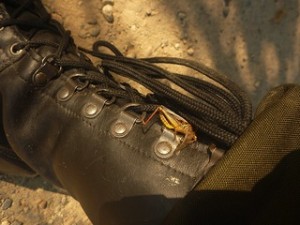10 Tips for Buying Motorcycle Boots
by Liz Jansen
When it comes to riding a motorcycle, feet are often the most taken for granted piece of equipment we have. Not only are they our form of transportation when we’re off the bike, we count on them for balance, traction and control. Protecting them can mean the difference between mobility and immobility.
 Good quality motorcycle boots address the many and diverse functions you count on them for. They provide balance when you’re stopped, activate controls, protect against impact and abrasion and repel rain. They’re comfortable both on and off the bike and look good.
Good quality motorcycle boots address the many and diverse functions you count on them for. They provide balance when you’re stopped, activate controls, protect against impact and abrasion and repel rain. They’re comfortable both on and off the bike and look good.
Rule out running shoes, sandals, flip-flops and high heels. Although they may be comfortable and/or make a fashion statement, save them for when you get off the motorcycle.
The style of boot will vary with the type of riding you do. Use these tips as a general guideline.
- Fit. Comfortable feet are essential for a comfortable ride. You want boots that fit snugly around your ankle while allowing you to wiggle your toes. An absorbent lining keeps your feet comfortable in the heat and warm when it’s cold out. Ironic as it sounds, you want boots that are hard to get on and off. They’re more likely to stay on during an accident.
- Traction. Look for soles that are oil-resistant and have good treads. Pavement can be slippery and uneven. When you put your foot down, you want to know it’s not going to slide across whatever surface you’re on.
- Water resistance. Ideally water proof. If you do any riding at all, at some point, you’re going to find yourself riding in the rain. Good boots keep water away from your feet through an effective surface and well-constructed double seams.
- Breathability. Feet get hot when they’re closed up for extended periods. A certain amount of this is unavoidable but high quality material and design can minimize it.
- Height. To adequately protect your feet, shin and ankles, select boots that come up to mid-calf. There are lots of bones, ligaments and tendons in to protect. An ankle injury will affect movement and function in your foot and leg.
- Armor. Look for padding for toes, ankles and shins. Bones are close to the surface and vulnerable to injury.
- Abrasion resistance. Recently I watched a rider slide thirty feet across the pavement after losing control of her bike. She wore a layer off one side of her boot but her foot was uninjured. Even during routine riding, you want to protect your feet from gravel or other objects that can fly up from the road surface. Extra padding
- Closures. Boots that lace up are actually better at protecting your feet than those that slip on. Done up tightly, laced boots keep water out and are not as likely to come off in an accident. Just make sure the laces are tucked in.
- Reflective bits. Whether it’s piping or inserts, even your feet play a role in making you conspicuous to others on the road. Headlights pick up reflective surfaces on heels and the sides of your feet.
- Movement. The primary purpose for boots is related to operating the motorcycle. Boots must offer enough flexibility to easily operate the brakes, be comfortable in the riding position and allow you to move your feet around while riding. Make sure the toe is slim enough to easily activate the shifter and heels don’t get hung up on foot pegs.
Do your research thoroughly before purchasing riding boots. The initial cash outlay may be high, but they’re a wise long-term investment. Not only will they last longer while giving you a comfortable ride, they’ll do a better job of protecting your feet. There’s no price tag for that.
photo credit: whirling_dervish via photopin cc

Great tips Liz! Amazing how many people do not wear the correct footwear. There are so many great choices available that cover all the guidelines and look great too!
Thanks for the reminder and sharing!
Lissa Hill
Thanks Lissa. Your feet are so close to the ground – and potential injury. Can’t figure out why people don’t value them more. Appreciate the comments.
Liz